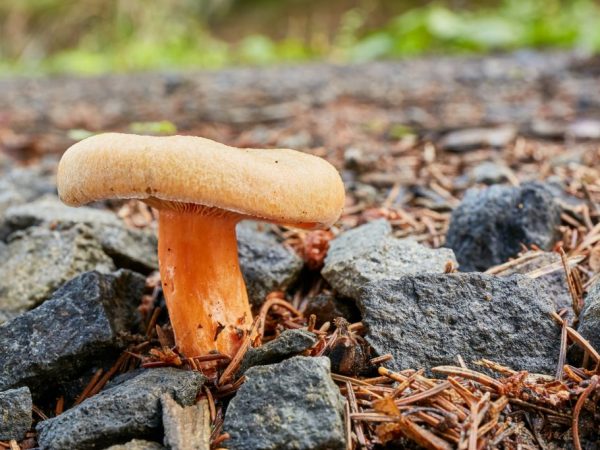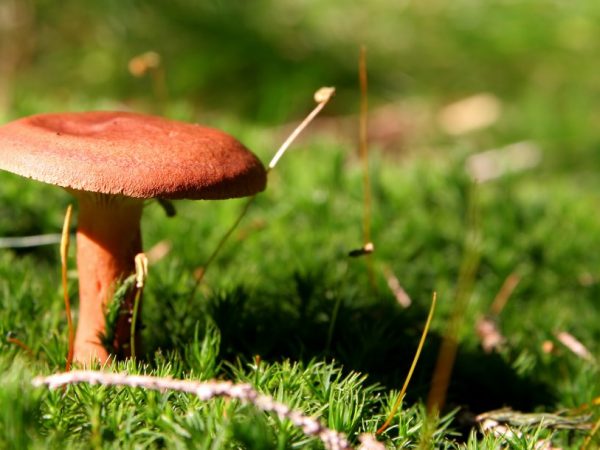Description of the mushroom spurge
The euphorbia mushroom (milkweed) is difficult to find on the territory of the country's forests, despite its prevalence. Most often, mushroom pickers take it for an inedible look, so they just walk by.

Description of the mushroom spurge
Description of the appearance of the mushroom
The thresher's hat has a unique look. It is fleshy, dense, red in color. Its diameter usually reaches 10 cm. The shape of the cap is flat, only in the center it has a small depression in the form of a funnel. When you feel the mushroom, it is noticeable that it is dry. The color is more often either red or brown with a shade of yellow, brown. Some specimens have a cracked cap surface.
When cut, it is noticeable that the pulp is white, after a while, under the influence of atmospheric oxygen, it becomes brown - it is oxidized. A white juice is released, similar to milk. For this reason, the brown mushroom has received an extraordinary name - "spurge". In the open air, the juice becomes black and viscous over time - it, like the pulp, oxidizes. Milky juice has a sweetish taste. This liquid is capable of acquiring the consistency of soft, dark colored rubber.
Irina Selyutina (Biologist):
The euphorbia mushroom is often called the rootlet or the red-brown milk mushroom (because of the bright color of the cap). It is found in central and southern Russia. Mycorrhiza forms with oak, hazel (hence the name), occasionally with spruce, settles in all types of forests where these woody species are present. Thanks to its milky juice, this species is one of the few completely non-bitter species that belong to the genus Mlechnik. Its juice, used for medicinal purposes, must be collected immediately before consumption due to its rapid coagulation.
Fruiting is observed in July-October.
Similar types of mushroom
According to the description, there are several similar types of mushrooms. Most popular:
- the milkman is not caustic;
- gray-pink milky and other similarly colored representatives of the genus Millechnik, which are smaller, smooth and uncracked skin of the cap, and they do not have the milky juice that sharply changes its color.
The rest of the species do not belong to the category of tasty and edible, so their description cannot be found among the safe representatives of this class. Other species have a bitter aftertaste, smooth surface, they do not have milky juice, which is an edible milkshake.
Useful and harmful properties
The fungus is characterized by the presence of a cleansing, anti-inflammatory property, and is also able to regulate the alkaline environment of the body. Euphorbia can act as an absorbent, so it is often used for poisoning or diarrhea. Miller removes heavy metal ions and salts from the body. It's filling and easy to digest.
There are also contraindications. During pregnancy, breastfeeding and children under 6 years of age, you must not use the milk jug for food.
Application

The mushroom has medicinal properties
This amazing mushroom is used in cooking and for the preparation of medicinal tinctures for various diseases.In some cases, it is used to treat tumors or venous veins.
In cooking
The leaflet has a fishy smell. During the cooking process, it becomes even more expressive. This is especially true for old mushrooms with a thick and hard skin. You should first soak the mushrooms for a few hours or overnight: this will help get rid of not only the smell, but also the insects and bacteria inside the cap.
Irina Selyutina (Biologist):
With its taste, the red-brown milk mushroom is very different from its congeners-milkmen, because it does not have their characteristic bitter taste. After cooking, the mushroom takes on a sweetish aftertaste. Those mushroom pickers who live in the regions where the plant is growing, believe that this edible mushroom can be eaten even raw and that it is good in pickled or raw salted form without heat treatment in principle.
For cooking, it is better to take young milkers, because the old ones really acquire the smell of rotten fish and taste corresponding to the "aroma".
This ingredient is suitable for preparing first and second courses, salads, pies.
In medicine
According to the description, the fruiting bodies of the euphorbia mushroom contain useful enzymes and trace elements, volemolid (a derivative
mushroom ergosterol), sterol, cortisone, volemitol (a seven-carbon sugar alcohol). Thanks to such a large accumulation of nutrients, the leaf root is the basis of many recipes for traditional medicine.
In the case of oncological diseases, this fungus is rubbed at the site of the tumor. Ethanol extract of this mushroom has a positive effect on the suppression of sarcoma. Also, the mushroom is used for the manufacture of drugs that prevent the development of inflammation and rheumatism.
Tincture on the base of the rootstock treats hemorrhoids, varicose veins and diseases associated with varicose veins. It is used twice a day for 1 tsp. The same dosage is used for angina, otitis media, runny nose and even with fever.
Supporters of traditional medicine use milkweed tincture, since it is capable of curing a large number of diseases. In case of poisoning or diarrhea, they simply eat a piece of bread soaked in it.
To cure an ulcer or acute gastritis, drink 1 tsp. mushroom juice three times a day.
Conclusion
Despite the fact that the spurge mushroom is a rare guest in our latitudes, its popularity is higher than that of many other edible species. If the mushroom picker has managed to find and cut the leaflet, he is a real lucky one.



